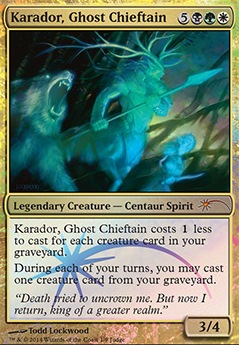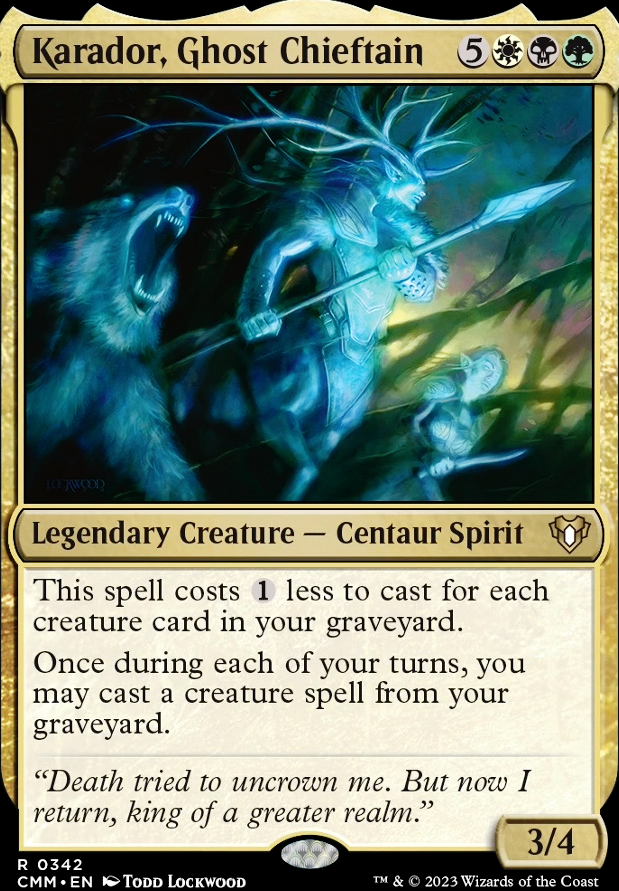
Karador Midrange Primer (cEDH)
Commander / EDH BGW (Abzan, Junk) Competitive Hatebears Infinite Combo Midrange Toolbox
Creature (37)
- 1x Academy Rector
- 1x Arbor Elf
- 1x Archon of Emeria
- 1x Avacyn's Pilgrim
- 1x Aven Mindcensor
- 1x Birds of Paradise
- 1x Blood Artist
- 1x Bloom Tender
- 1x Carrion Feeder
- 1x Collector Ouphe
- 1x Dark Confidant
- 1x Deathrite Shaman
- 1x Drannith Magistrate
- 1x Elesh Norn, Grand Cenobite
- 1x Elves of Deep Shadow
- 1x Elvish Mystic
- 1x Eternal Witness
- 1x Fauna Shaman
- 1x Grand Abolisher
- 1x Hermit Druid
- 1x Karmic Guide
- 1x Linvala, Keeper of Silence
- 1x Llanowar Elves
- 1x Protean Hulk
- 1x Ranger-Captain of Eos
- 1x Razaketh, the Foulblooded
- 1x Reclamation Sage
- 1x Renegade Rallier
- 1x Reveillark
- 1x Saffi Eriksdotter
- 1x Satyr Wayfinder
- 1x Stinkweed Imp
- 1x Stitcher's Supplier
- 1x Sun Titan
-
1x
Tymna the Weaver

- 1x Viscera Seer
- 1x World Shaper
Land (30)
- 1x Bayou
- 1x Brushland
- 1x City of Brass
- 1x Command Tower
- 1x Forest
- 1x Godless Shrine
- 1x Horizon Canopy
- 1x Isolated Chapel
- 1x Llanowar Wastes
- 1x Mana Confluence
- 1x Marsh Flats
- 1x Nurturing Peatland
- 1x Overgrown Tomb
- 1x Phyrexian Tower
- 1x Plains
- 1x Prismatic Vista
- 1x Riftstone Portal
- 1x Savannah
- 1x Scrubland
- 1x Silent Clearing
- 1x Snow-Covered Forest
- 1x Snow-Covered Plains
- 1x Snow-Covered Swamp
- 1x Strip Mine
- 1x Sunpetal Grove
- 1x Swamp
- 1x Temple Garden
- 1x Verdant Catacombs
- 1x Windswept Heath
- 1x Woodland Cemetery
Enchantment (7)
Commander (1)
Instant (12)
- 1x Abrupt Decay
- 1x Assassin's Trophy
- 1x Eladamri's Call
- 1x Enlightened Tutor
- 1x Entomb
- 1x Force of Vigor
- 1x Noxious Revival
- 1x Silence
- 1x Vampiric Tutor
- 1x Veil of Summer
- 1x Worldly Tutor
Sorcery (7)
- 1x Buried Alive
- 1x Demonic Tutor
- 1x Eldritch Evolution
- 1x Finale of Devastation
- 1x Life / Death
- 1x Reanimate
- 1x Toxic Deluge
Artifact (6)
Suggestions
Updates Add
Comments
Attention! Complete Comment Tutorial! This annoying message will go away once you do!
Important! Formatting tips — Comment Tutorial — markdown syntax
Please login to comment
Casual
98% Competitive
| Date added | 3 years |
| Last updated | 3 years |
| Legality | This deck is Commander / EDH legal. |
| Rarity (main - side) | 14 - 0 Mythic Rares 51 - 0 Rares 20 - 0 Uncommons 9 - 0 Commons |
| Cards | 100 |
| Avg. CMC | 2.44 |
| Folders | Nethroi Inspo |
| Votes | |
| Ignored suggestions | |
| Shared with | |
| Views |


